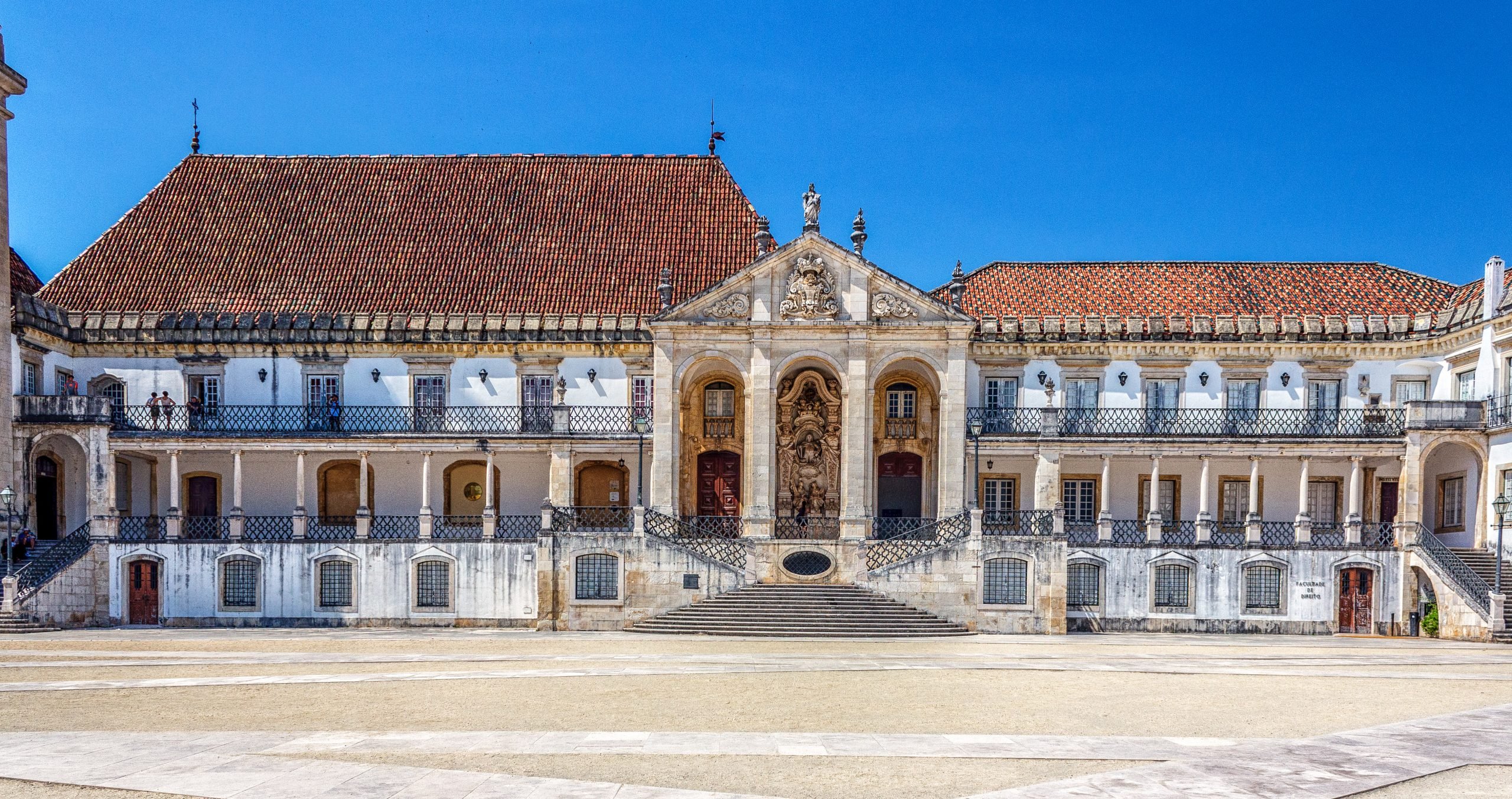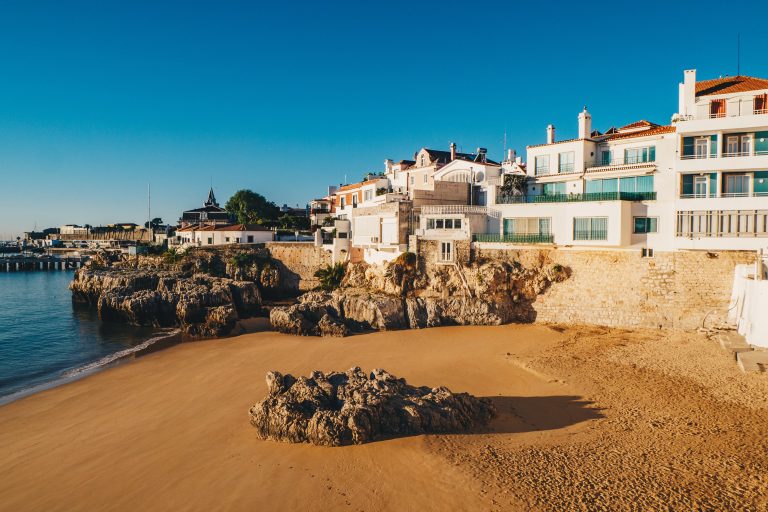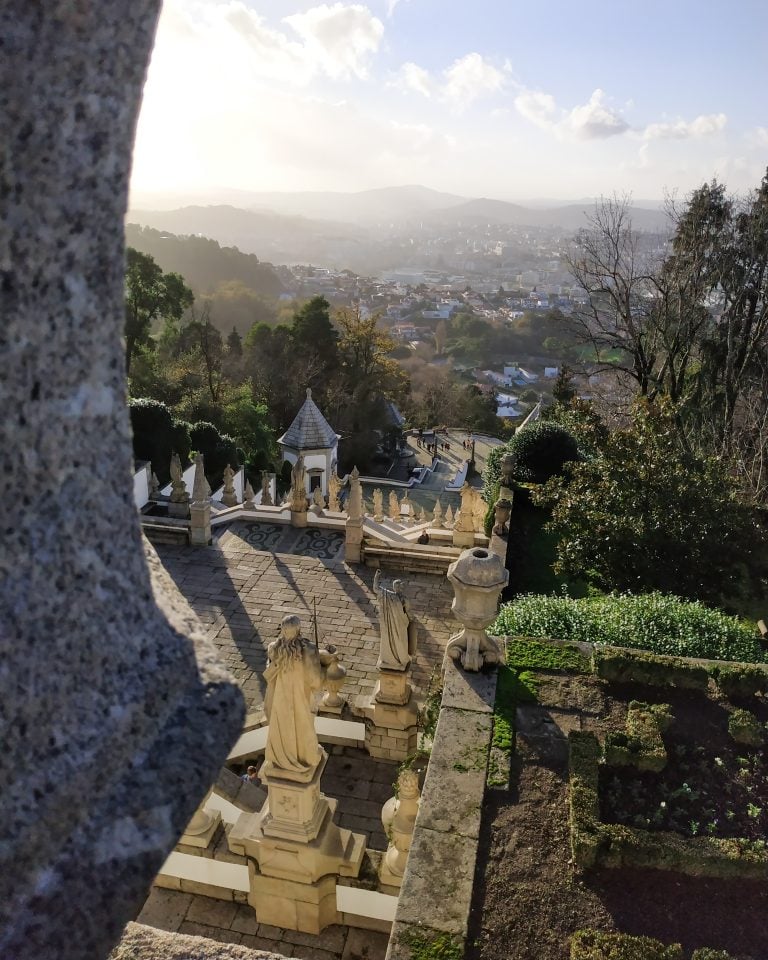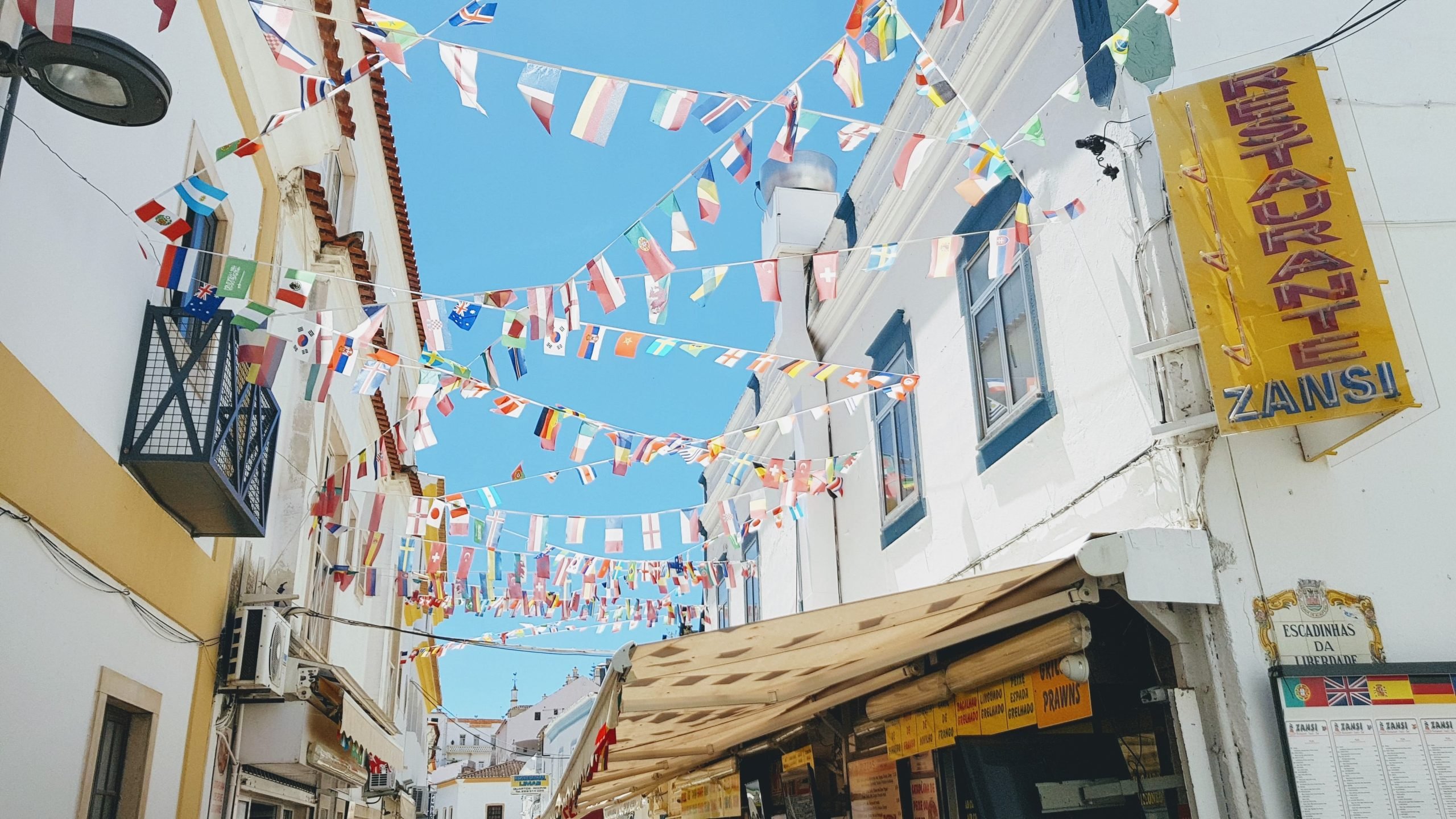If you’re looking for a getaway and a good starting point to see the Alentejo, then the historic capital of the region is the best place to go! Évora, considered the Portuguese city with the second-best living conditions, is around 1,300 sq km (or about 500 sq mi) and has around 50,000 people.
Competing with Braga in seniority, the city has a history dating back more than five millennia. In Évora, you can travel to the different times that the city has lived through, from the Romans, passing through the times of the Inquisition until the 1900s. It’s generations and generations of different types of people and cultures that have walked that same ground! Many of them, even the same cobbled streets as we are walking!
Its Historical Center was the second one in Portugal to be considered a UNESCO World Heritage Site and is fairly quick to see, with 1.05 km2 (0.41 sq mi). There you can find amazing buildings like the Roman Temple, the Évora Cathedral, the Bones Chapel, the Aqueduct, and over 400 historical buildings in this incredible walled city.
The typical Portuguese sidewalk (“Calçada Portuguesa”) fills the streets of this time-traveling city. On each side of its narrow streets, you will find houses that tell history in each of their stones.
Once the residence of kings, this museum-city will take you on a journey through space and time, with its historic scenery and its monuments that inspired Brazilian architecture.
Getting to Évora
Lisbon to Évora
You should drive 140 km east out of Lisbon along the A6 highway, in the direction to Évora. This will take you around 1:30h. Or you can hire a Tesla to drive you and give you a tour.
You can also get there by bus, with Rede Expressos having daily buses to Évora from Sete Rios.
As for the trains, there are Lisbon-Évora rides four times a day out of Oriente, Sete Rios, and Entrecampos railway stations. However, Évora’s railway station is 1km south of the city center, about 20 minutes by walking.
Porto to Évora
This will be a loooong drive from Porto…
The quickest route is through the A1 and A6 motorways (around 410 km). This, with good traffic, takes around 4 hours!
As for bus and train, you should first get to Lisbon and then change the bus or train to the ones going to Évora.
How to Plan Your Visit
Day Trip to Évora from Lisbon: You can make this a day trip from Lisbon and explore the city in a day. Most of the interesting places are in the Historic Center and you can get to them pretty fast, but probably you won’t have that much time to explore the surroundings.
Stay in Évora and explore the surroundings: Explore the beautiful city and the rest of Alentejo! Head on to the Great Lake of Alqueva, the wonderful Beja, founded by Emperor Julius Caeser himself, to Elvas, the largest walled city in the world, or to Évoramonte, where you will find an amazing castle with a peculiar architectural feature! You can also visit Vila Viçosa or Viana do Alentejo, two beautiful Alentejan towns, or even go to the Spanish city of Badajoz or Mérida. And if you are a political fun facts aficionado, you can head on to Olivença/Olivenza, a town on the border that is claimed by both Portugal and Spain.
Where to eat in Évora
At Praça do Giraldo you will find lots of restaurants to choose from with regional traditional cuisine! The main dishes you can find in the city are tomato soup, purslane (‘beldroegas’), ‘toucinho’ (a type of bacon), dogfish, ‘açorda’ (a traditional bread soup), and the well-known convent sweets. In many bakeries, you can also find the famous ‘Queijada de Évora’ or the ‘grala bread’, try it out!
If you are looking for more modern and different food from the traditional, then head on to Alcárcova de Baixo Street, one of the ‘trendiest’ streets in the city.
Nightlife in Évora
You will find some cafés and bars open at night, where you can have a coffee or a drink. If you feel like it, you can even find some nightclubs (as a student city too, Évora has to have places to party!).
Besides all of this, you can have a quiet walk around the Historic Center, watching the lights illuminating the historic houses, churches, and the Temple. Alentejo is the hottest part of Portugal, and even though it gets colder at night in the colder months, you can have a comfortable walk if you take a good jacket.
What to do in Evora
It is usually joked that in Évora, every kick on a rock will reveal an archeological treasure, due to its millennia of human history. And you will experience this if you visit it!
Book Tours & Experiences in Evora
Here are the main attractions that you HAVE to see in Évora:
Praça do Giraldo
This square is the living heart of the city. Under the hot Alentejan sun, you will see the locals resting on a bench there or next to the water fountain. Wonderful archways and the typical Alentjean white walls (to reflect the sunlight and not absorb it) surround this central square, giving it the authentic and traditional look of the region.
You can find a very bustling market there on the weekends, and on the other days, you can shop in the several stores under the archways. In the summertime, the restaurants in the square will have some tables outside and you will see the square filled with life, with families having lunch and people having coffee and chatting. You can also find some music concerts or street theaters happening in the square if you are lucky!
The square is said to have been named after Geraldo Sem-Pavor (Geraldo the Fearless), an outlaw who expelled the Moors from the city. With the passage of time, Geraldo turned to Giraldo and the name stayed, the Square of Giraldo.
Rua Cinco de Outubro
Going through the arches of the square, we reach the 5th October Street, named after the day of the Implementation of the Republic in Portugal.
This street is filled with handicraft shops, from carved cork, by which Portugal and the Alentejo more specifically are very well-known, to copperware. It is very tourist-centered, with lots of souvenir shops, but nonetheless a must-go street! You can even find here the famous Queijadas de Évora that I’ve talked about eating!
You can also see living houses with the neighbors talking to each other in the windows while letting the airflow through the house (the heat is not to joke about here!).
Sé Catedral de Évora
The Cathedral of Évora is one of the most majestic Cathedrals that make up the Portuguese religious patrimony and the largest medieval Cathedral in Portugal.
The building is of Romanesque origin, as it was built in this style in 1204, but through the ages, it faced several changes. Now, it has traces of various other architectural styles, such as Plateresque, Gothic, or Baroque.
On the main door, you can see a wonderful 14th-century sculpture of the Apostles, before walking inside, and seeing it is as wonderful as outside.
You can also visit the sacred art museum inside and its terrace, where you will have a privileged view of the city from its high towers.
Templo Romano de Évora
Also called “Diana’s Temple” (even though this was then found out to be wrong) the Roman Temple is one of the most emblematic monuments in all of Portugal, considered one of the most important legacies left in the two millennia of Roman history in the region.
It is believed to have been built in the 1st century AD, its surviving columns have survived over 2.000 years, being themselves a monument of masonry.
In that same square, you will also find the Jardim Diana (Diana Garden), with its romantic flowers as if they are watching over the Temple, and the Évora Museum, a former 16th-century palace that houses the entirety of the city’s history under its roof. At night, the temple is lightened, filling it with an even bigger sense of grandiosity.
Termas Romanas de Évora
The Roman Baths were the place where people would bathe, hang out, and make business. Now, it is part of the rich legacy of this city, as a former Roman city.
Dating back to the 1st century AD, these Baths were very recently discovered, only in 1987, when some excavations were being made in the old part of the Hall. It is complete with a brick doorway, a sunken room with a circular steam bath, vestiges of a furnace (that was used as a central heating system), and an open-air swimming pool.
Situated inside of what is now the City Hall, the Roman Baths can be visited for free, from Monday to Friday during office hours.
Palácio Cadaval
The Cadaval Palace incorporates parts of the city’s old castle and the Lóios Church or Church of Saint John the Evangelist.
This Church’s modest exterior does not do justice to its inside. Completely filled with 18th-century azulejos depicting the life of Saint Lawrence, this will leave you in constant awe throughout your visit.
The Church also holds a secret. It was built on top of the ruins of a Moorish castle, and here, on the cistern of this castle, a crypt was made to house the bones of the friars of the Lóios Convent. You can access it through a trapdoor among the benches. If it’s locked, just ask the Church’s caretaker to open it up!
Today, besides the Church, it features a patio, where you can enjoy a relaxing coffee, a luxurious Inn and a restaurant, as well as the famous Tower of the Five Corners, said to be haunted. It is still a private residence, where you can see the valuable Cadaval family collection of paintings, manuscripts, sculptures, armor, and weaponry from the 15th until the 18th centuries.
Mercado Municipal de Évora
A symbol of the local economy, the Municipal Market is where life starts in Évora, with the local population rushing to the spot to get the freshest local products.
If you want to get a taste of the normal life in Évora and get traditional local products, like Alentejan cheeses or regional cakes, this is the place! You can also have a relaxed coffee or breakfast in its cafés while talking to the locals, or even an ice cream at the ice cream shop.
It is open between 7h and 18h, every day except Monday.
Igreja de São Francisco e Capela dos Ossos
The Church of St. Francis is, together with the Cathedral, one of the first things you can see when you arrive in Évora, rising out of a hill in the Alentejan plains.
This Church is made in the Gothic-Manueline style, being originally in a Romanesque one, but little is left of it. It was the first convent where the Franciscans installed themselves in Portugal, making it of big religious and historical significance.
At the end of the 15th century, the kings started to give this, at the time, Convent more privileges, being nicknamed “the Convent of Gold”, because of all the richness that decorated it.
 But this Church also has a surprise (and yes, it also involves bones). The Capela dos Ossos (Bones Chapel) is made out of the remains of 5.000 monks, much more than the Lóios Church one (that’s why this is the main one and the most known).
But this Church also has a surprise (and yes, it also involves bones). The Capela dos Ossos (Bones Chapel) is made out of the remains of 5.000 monks, much more than the Lóios Church one (that’s why this is the main one and the most known).
This 16th-century chapel also features two dangling corpses, one even being of a child.
To make it even creepier, when you enter the chapel you can find a warning saying: “Nós ossos que aqui estamos, pelos vossos esperamos” (We bones that are here, await yours). Like, really??
Even though it seems like a really creepy place, it is actually the second most visited tourist attraction in Évora. People come because of the shock that it is to see a whole building made out of what once were humans, but also for the consciousness that it gives of the frailty of life.
Today it is not that much of a creepy place, it is well lit and you have visitors coming and going, so you will be fine! So if you think you only have a stomach for one bone chapel and you’re wondering between this one and the Lóios one, I would recommend this one.
Universidade de Évora
The building of Évora’s old university is amazing. Built with sculpted marble and with walls covered in azulejos, the building itself invites you to come in. When you do that, you will get even more amazed when you see the classroom walls decorated with panels of each of the subjects taught.
You can also find an 18th-century Baroque chapel, known as ‘Sala dos Atos’. You can ask the caretaker for the key if you want to explore it!
The collection of buildings was inaugurated in 1559 and it is still used by students, so you should check with the workers there if you can explore.
Aqueduto da Água de Prata
The Aqueduct of Silver Water is so incredible that it was spoken about by the great Portuguese poet, Luís de Camões, who described it in its masterpiece “Os Lusíadas”. The structure can be seen throughout the city, going for 9km and reaching a height of 26 meters.
As it reaches closer and closer to the center of the city, the Aqueduct mixes together with the houses, shops, and warehouses that were built within its arches. You can see the traditional houses of Alentejo, painted white, light blue, or yellow, that use it as a doorway. You can find lots of them around Rua do Cano.
Definitely, a place to check!
Alto de São Bento
Overseeing the whole city, this well-kept secret has the best panoramic view of Évora. Next to the old windmills and the Museological Center, you can sit there and watch a breathtaking sunset over Évora, perhaps accompanied by your loved one, with some friends or enjoying your well-deserved alone time.
Jardim Público
The Public Garden of Évora is a great garden if you are looking for colors and plant diversity. You can enjoy a quiet time there, a wonderful picnic and, as always in this city, a bit of history. Here are the remains of the Medieval Wall, D. Manuel Palace, and the Ruínas Fingidas (or Faked Ruins, named this way because they were built in 1863 by Italian choreographer Giuseppe Cinnatti with ruins of several monuments in the city).
You are guaranteed to enjoy your walk there and, if you’re lucky, you might even find some company in the peacocks that walk around the Gardens.
Megaliths Tour
If you want to adventure a bit outside of the city, you can go on this Megaliths Tour until the Cromeleque dos Almendres (Cromlech of Almendres), an oval-shaped monolith made up of 95 granite stones that date back to the end of the 6th millennia BC.
It is believed to have been a temple dedicated to the sun, with the circle serving as an astronomical observatory. But the mystery stays on what is the Menhir of Almendres, a 2.5 meter stone found 1.5km from the Cromlech.
You can visit the sites through a marked trail and tour them with local archeologists, to get a better understanding of what is known (and unknown) about this structure.
Book Megaliths Tour
Booking.com
Final Remarks
Évora is a millennia-old city that still endures in the 21st century. Marked by the passage of the years, with history built upon history (quite literally, in the case of the Lóios Church), a visit to it is a necessary one if you are around.
If you have an interest in understanding the Alentejan way of life, the culture, the architecture, the history, and the mentality, just walk through the streets of Évora and immerse yourself in the city. Talk to the friendly people that will surely approach you, have a coffee around, eat and drink in the local ‘tascas’!
But don’t forget that it still is the capital of the region, and in the capitals, you usually can’t have quite the feeling of the rest of the region (you know, “big city” life), so be sure to see the rest of Alentejo and its beautiful towns and people.
In any way, usually, 2 days is enough to visit the historical city and the surroundings, and if you do want to visit the rest of Alentejo, Évora is a great jumping start to visit the whole region! I hope you have a chance to visit this wonderful place and I hope you enjoy it!
⬇️What are your favorite things to do in Evora? Let us know in the comments below⬇️



 But this Church also has a surprise (and yes, it also involves bones). The Capela dos Ossos (Bones Chapel) is made out of the remains of 5.000 monks, much more than the Lóios Church one (that’s why this is the main one and the most known).
But this Church also has a surprise (and yes, it also involves bones). The Capela dos Ossos (Bones Chapel) is made out of the remains of 5.000 monks, much more than the Lóios Church one (that’s why this is the main one and the most known).









